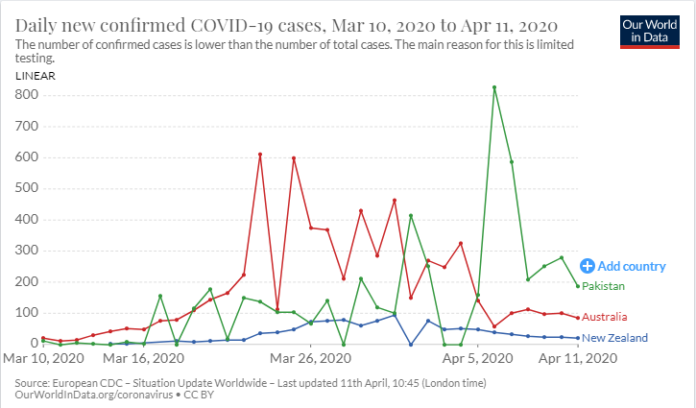Dr Farooq Yousaf

As the global community is still finding ways to contain the deadly spread of coronavirus (COVID-19), both Australia and New Zealand are effectively working towards “flattening the curve” of daily new cases of COVID-19 infections. These two countries present concise case studies of effective tackling of the deadly pandemic not only for Pakistan but also for the rest of the world.
As of April 10, 2020, the total of COVID-19 cases in Australia, New Zealand and Pakistan stand at 6152, 1015, and 4601 respectively. Even though the number of cases in both Australia and New Zealand is still on the lower side, when compared with other “western” states, their response has been somewhat swift, systematic and aggressive.

Australia has enforced strict measures for both its citizens and residents as well as international visitors and visa holders. On March 19, Australian PM Scott Morrison, without any prior warning, announced to close the country’s borders to all “non-citizens”. This meant that other than Australian citizens, permanent residents and those on special status visas, no one was allowed to enter the country after the PM’s announcement.
Moreover, the country also imposed a strict quarantine policy for all citizens and permanent residents arriving in Australia. The Department of Home Affairs, in that regard, says that:
All travellers arriving in Australia must undertake a mandatory 14-day quarantine at designated facilities (for example, a hotel), in their port of arrival.
For international citizens in Australia, the government suggests:
Due to the current situation in Australia due to COVID-19, including state and territory border restrictions, business closures and social distancing requirements, all international visitors are encouraged to depart if it is possible to do so.
Similarly, New Zealand, which is one of few countries to have effectively contained the spread of COVID-19 in recent days, has also implemented an “Alert Level 4 – Eliminate” for the pandemic. Level 4 Alert implies that “it is likely that the disease is not contained”. According to Michael Baker and Nick Wilson, writing for The Guardian, this “elimination approach” by New Zealand is different from the “mitigation” approach of managing the “pandemic influenza”. According to them:
With mitigation, the response is increased as the pandemic progresses, and more intensive interventions such as school closures are often held in reserve to “flatten the peak”. By contrast, disease elimination partly reverses the sequence by using vigorous interventions early to interrupt disease transmission. It is due to this aggressive approach that the number of daily new cases in both Australia and New Zealand is steadily falling as can be seen in Fig 1 below.

A major take away from both Australia and New Zealand is the fact that both the countries were able to implement an early lock-down, by not only enforcing social distancing measures but also recommending that all non-essential workers work from home. Moreover, both countries also shut down their borders for international travel. By doing that, both the countries effectively controlled the transmission chain of the virus; buying essential time to implement their virus-elimination measures. Hence, these played a major role in “flattening the curve” of virus transmission in both countries.
When it comes to testing, we find that both Australia and New Zealand boast a higher number of “tests per 1000 people” when compared to Pakistan.

In terms of the total number of tests, Australia has so far conducted 338,000 tests, New Zealand 59,000 and Pakistan 58,000 COVID-19 tests (see above Fig 3). Therefore, where Australia and New Zealand’s “tests per 1000 people” number stands at 13.2 and 12.1 respectively, Pakistan, on the other hand, has conducted a paltry 0.28 tests per 1000 people (see below Fig 4).

Having discussed these measures, it is also worth noting that not all countries enjoy the luxury of pursuing the “elimination strategy”. Such a strategy can only work for countries that can effectively seal their borders and can bear the immense costs of testing and healthcare support. Therefore, it comes as no surprise that the European continent and the US followed the “mitigation” strategy, which not only overburdened the healthcare system but also resulted in high infection and transmission rates.
However, even with such complications, a major lesson for Pakistan that needs to be learnt from both Australia and New Zealand is following a clear and concise policy. Both these countries, from the early rise in numbers of infections, were clear in their approach and policy actions. Even though Pakistan might not enjoy the favourable conditions – such as easy to manage borders and a stable economy – it can still ensure that its “mitigation strategy” for containing the coronavirus pandemic is clear and well laid-out. Only a clear policy and its implement can, therefore, pull Pakistan out of this global health catastrophe that has claimed thousands of lives.
(Data Source: Our World in Data)
The author holds a PhD in Politics from the University of Newcastle and is currently based in Australia.




